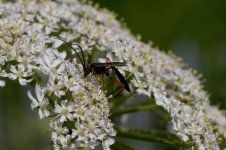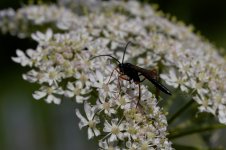DoghouseRiley
Well-known member
Hi All
I sort of thought that this would be one of those frustrating wasps that would be very difficult to get any sort of identification but...............................
On close examination the eyes seem to have this pale halo and the lower part of the rear legs are very pale, almost white.
This is shown in the second photo.
Hopefully these two characteristics could help some kind sole to ID this, because I have searched far and wide and I am struggling.
Thanks, Gareth
I sort of thought that this would be one of those frustrating wasps that would be very difficult to get any sort of identification but...............................
On close examination the eyes seem to have this pale halo and the lower part of the rear legs are very pale, almost white.
This is shown in the second photo.
Hopefully these two characteristics could help some kind sole to ID this, because I have searched far and wide and I am struggling.
Thanks, Gareth





